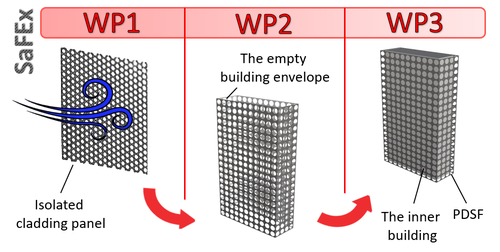Safe Design of Porous Façades Exposed to Extreme Wind Conditions
SaFEx is a two-year research project funded under the PRIN 2022 programme by the Italian Ministry of University and Research (MUR). It addresses the urgent need to improve the wind-resistant design of Permeable Double Skin Façades (PDSFs) — an increasingly popular architectural solution for energy-efficient buildings.

PDSFs consist of a solid inner façade and an outer porous cladding that reduces solar gains and creates a ventilated buffer zone. Despite their growing adoption, PDSFs pose significant challenges in terms of wind loading prediction and safety verification, due to their inherently multiscale geometry (see Fig. 1) and the limitations of existing experimental and numerical methods.

Objectives
Methodology
The project aims at combining high-fidelity CFD simulations (by the University of Bologna) and large-scale wind tunnel tests performed at Polytechnic of Milan). It focuses on:
Expected Impact
SaFEx aims to:
Consortium
People
Luca Patruno (University of Bologna, PI)
Stefano de Miranda (University of Bologna)
Giovanni Lazzeri (University of Bologna)
Claudio Somaschini (Polytechnic of Milan, Co-PI)
Paolo Schito (Polytechnic of Milan)
Giulia Pomaranzi (Polytechnic of Milan)
Marcello Catania (Polytechnic of Milan)
